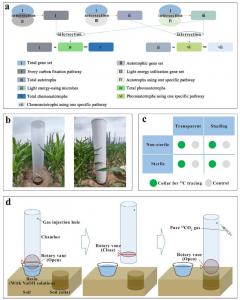Exploring microbial carbon fixation in semiarid farmlands: a path to sustainable agriculture
GA, UNITED STATES, August 7, 2025 /EINPresswire.com/ -- In semiarid farmlands, microbes are quietly shaping the planet’s carbon cycle. This study uncovers the crucial role that photoautotrophic and chemoautotrophic microbes play in fixing atmospheric CO2 into soil organic carbon (SOC). Through groundbreaking metagenomic and 13CO2 isotope tracing methods, researchers reveal that although chemoautotrophs dominate in abundance, photoautotrophs perform carbon fixation at a far higher rate per unit of microbial abundance. These findings not only provide a deeper understanding of carbon dynamics in semiarid soils but also highlight the potential of soil microbes in climate change mitigation efforts. This research could be the key to unlocking soil's carbon storage potential.
Soil is one of the largest carbon reservoirs on Earth, yet its ability to capture and store atmospheric CO2 is still not fully understood. In semiarid farmlands, the process of soil carbon sequestration is critical but complex, influenced by the microbes that inhabit these soils. While much attention has been given to traditional carbon-fixing methods, such as crop residue management, the role of soil microbes, particularly photoautotrophs and chemoautotrophs, has been underexplored. With rising concerns over climate change, it is vital to understand how these microbes contribute to soil's capacity to act as a carbon sink. This knowledge could revolutionize strategies for managing soil carbon.
Published (DOI: 10.1016/j.pedsph.2025.03.004) in Pedosphere, this study conducted by researchers from China Agricultural University, the Chinese Academy of Sciences, and others, sheds light on how soil microbes contribute to carbon fixation in semiarid farmlands. By combining metagenomics with 13CO2 isotope tracing, the research team was able to identify the dominant microbial species involved and assess their carbon fixation rates. Their work reveals that both photoautotrophs and chemoautotrophs play significant roles in fixing carbon, but their rates differ, offering new insights into the microbial dynamics that influence soil carbon storage in arid agricultural regions.
In this pioneering study, researchers identified and classified autotrophic microbial species from semiarid farmlands, using advanced sequencing and isotope labeling techniques. The study uncovered that chemoautotrophs comprised the majority of autotrophic microbes, accounting for 86.4% of the total, while photoautotrophs made up 13.6%. Despite their lower abundance, photoautotrophs exhibited significantly higher carbon fixation rates per unit of microbial abundance, approximately 1.5 times greater than their chemoautotrophic counterparts. The research also revealed that both groups of autotrophs utilize six distinct carbon fixation pathways, contributing to functional redundancy that enhances their ability to adapt to varying environmental conditions. The in situ 13CO2 pulse labeling experiment demonstrated that photoautotrophs and chemoautotrophs, working together, are capable of fixing CO2 at an impressive rate of 5.961 mg C m-2 d-1. This study offers a fresh perspective on the roles of microbial communities in the carbon cycle, highlighting the importance of both types of autotrophs in maintaining soil health and climate resilience.
Dr. Keyu Fa, the study's corresponding author, emphasized the broader implications of the findings: "Our research highlights the crucial role that photoautotrophs and chemoautotrophs play in carbon fixation in semiarid farmlands. These microbes not only help sequester atmospheric CO2 but also enhance the resilience of agricultural soils to climate variability. By understanding the intricacies of microbial carbon fixation, we can develop more effective strategies to improve soil carbon storage and support sustainable farming practices. This work lays the groundwork for future research on harnessing microbial activity for climate change mitigation."
The implications of this study extend far beyond the laboratory, offering actionable insights for land management strategies aimed at enhancing soil carbon sequestration. By understanding the microbial processes involved in carbon fixation, farmers and land managers can optimize practices such as crop residue management, organic fertilization, and irrigation to support the growth of carbon-fixing microbes. Additionally, the findings could inform global efforts to increase soil carbon storage, contributing to climate change mitigation. As agricultural practices evolve, harnessing the power of soil microbes to capture and store carbon may play a pivotal role in creating more resilient, sustainable farming systems.
DOI
10.1016/j.pedsph.2025.03.004
Original Source URL
https://doi.org/10.1016/j.pedsph.2025.03.004
Funding information
This work was supported by the National Natural Science Foundation of China (Nos. 51909266), the Science and Technology Basic Resources Investigation Special Project of China (No. 2021FY100703) and the National Field Scientific Observation and Research Station on Efficient Water Use of Oasis Agriculture in Wuwei of Gansu Province (No. KF2021001).
Lucy Wang
BioDesign Research
email us here
Legal Disclaimer:
EIN Presswire provides this news content "as is" without warranty of any kind. We do not accept any responsibility or liability for the accuracy, content, images, videos, licenses, completeness, legality, or reliability of the information contained in this article. If you have any complaints or copyright issues related to this article, kindly contact the author above.

